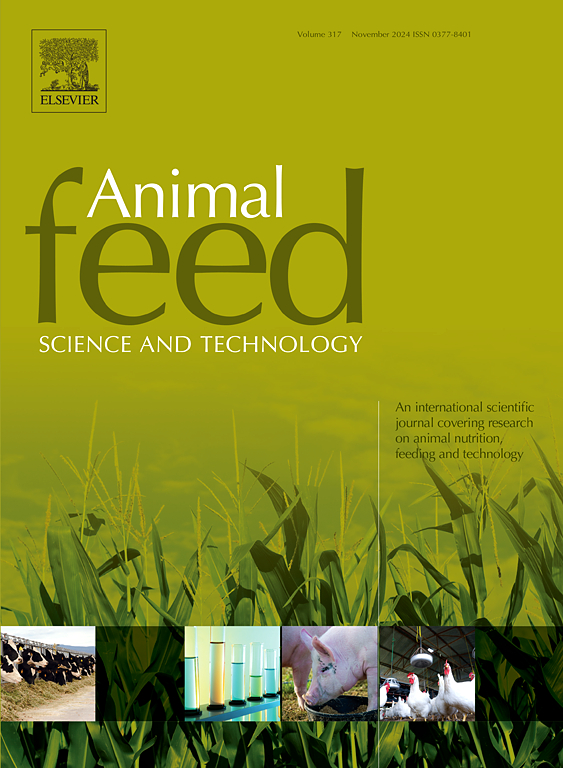Dietary supplementation with Schizochytrium Limacinum in a plant protein-based diet on growth performance, flesh quality, myofiber development, and antioxidant profile of Litopenaeus vannamei
IF 2.7
2区 农林科学
Q1 AGRICULTURE, DAIRY & ANIMAL SCIENCE
引用次数: 0
Abstract
This research aimed to evaluate the effect of supplementing Schizochytrium Limacinum (S. Limacinum) to a plant protein-based diet on growth performance, flesh quality, myofiber development, and expression of antioxidant-related genes in Litopenaeus vannamei (L. vannamei). Shrimp (initial body weight: 0.25 ± 0.00 g) were fed three isonitrogenous and iso-lipidic diets (HF, 25 % fish meal (FM); LF, SPC and CPC replaced 60 % FM; LFD, LF diet supplemented with 0.8 % S. Limacinum) for 8 weeks. The results showed that the weight gain rate, specific growth rate, and final weight of shrimp were significantly increased in the LFD group compared to the LF group (P < 0.05). In addition, intestinal protein synthesis-related genes (target of rapamycin, tor; eukaryotic translation initiation factor 4E-binding protein, 4ebp; eukaryotic translation initiation factor, eif3k; ribosome protein S6 kinae, s6k1; raptor) were significantly upregulated in shrimp fed the LFD diet compared to shrimp fed the LF diet (P < 0.05). Muscle flesh quality (hardness, chewiness, and gumminess) of shrimp fed the LFD diet were significantly improved compared to those fed the LF diet (P < 0.05). Moreover, the expression of myofiber development and antioxidant-related genes (smych5, smych15, sod, gpx) were significantly higher in shrimp fed the LFD diet than those fed the LF diet (P < 0.05). In conclusion, supplementation of 0.8 % S. Limacinum in a plant protein-based diet improved the growth performance of shrimp, as well as promoted the flesh quality, myofiber development and the anti-oxidative ability of shrimp.
植物蛋白基础饲粮中添加裂唇藻对凡纳滨对虾生长性能、肉质、肌纤维发育和抗氧化特性的影响
本研究旨在评价在植物蛋白基础饲粮中添加半裂虾(Schizochytrium Limacinum, S. Limacinum)对凡纳滨对虾(Litopenaeus vannamei, L. vannamei)生长性能、肉质、肌纤维发育和抗氧化相关基因表达的影响。试验对虾(初始体重:0.25 ± 0.00 g)投喂3种等氮等脂饲料(HF, 25% %鱼粉;LF、SPC、CPC代替60% % FM;低脂、低脂饲粮中添加0.8 % S. Limacinum,持续8周。结果表明:与LF组相比,LFD组对虾的增重率、特定生长率和末重均显著提高(P <; 0.05)。此外,肠道蛋白合成相关基因(雷帕霉素靶基因,tor;真核翻译起始因子4e结合蛋白;真核生物翻译起始因子eif3k;核糖体蛋白S6激酶,s6k1;与低脂饲料相比,低脂饲料显著上调了猛禽蛋白的表达量(P <; 0.05)。与低脂饲料相比,低脂饲料显著提高了虾的肌肉品质(硬度、嚼劲和胶性)(P <; 0.05)。此外,低脂肪对虾肌纤维发育和抗氧化相关基因(smych5、smych15、sod、gpx)的表达量显著高于低脂肪对虾(P <; 0.05)。综上所述,在植物蛋白基础饲粮中添加0.8 %山楂可改善对虾的生长性能,促进肉质、肌纤维发育和抗氧化能力。
本文章由计算机程序翻译,如有差异,请以英文原文为准。
求助全文
约1分钟内获得全文
求助全文
来源期刊

Animal Feed Science and Technology
农林科学-奶制品与动物科学
CiteScore
6.00
自引率
6.20%
发文量
266
审稿时长
3 months
期刊介绍:
Animal Feed Science and Technology is a unique journal publishing scientific papers of international interest focusing on animal feeds and their feeding.
Papers describing research on feed for ruminants and non-ruminants, including poultry, horses, companion animals and aquatic animals, are welcome.
The journal covers the following areas:
Nutritive value of feeds (e.g., assessment, improvement)
Methods of conserving and processing feeds that affect their nutritional value
Agronomic and climatic factors influencing the nutritive value of feeds
Utilization of feeds and the improvement of such
Metabolic, production, reproduction and health responses, as well as potential environmental impacts, of diet inputs and feed technologies (e.g., feeds, feed additives, feed components, mycotoxins)
Mathematical models relating directly to animal-feed interactions
Analytical and experimental methods for feed evaluation
Environmental impacts of feed technologies in animal production.
 求助内容:
求助内容: 应助结果提醒方式:
应助结果提醒方式:


